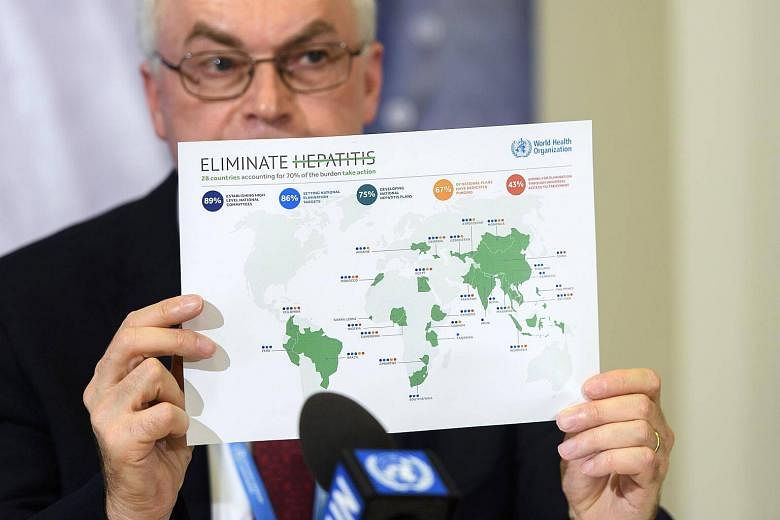Today is World Hepatitis Day, which is marked annually on July 28.
With no current cure for hepatitis B, the disease remains a big problem in Singapore and Asia. Worldwide, an estimated 257 million people are living with hepatitis B infection. Regionally, in South-East Asia, hepatitis B affects about 3.3 per cent of the population, according to the World Health Organisation.
One person dies of viral hepatitis every 30 seconds in the Asia-Pacific, says the Coalition to Eradicate Viral Hepatitis in Asia Pacific (CEVHAP).
In 2015, hepatitis B resulted in 887,000 deaths globally, mostly from complications such as cirrhosis and liver cancer. The virus causes 45 per cent of liver cancer cases and 63 per cent of liver cirrhosis, which is hardening or scarring of the liver.
In Singapore alone, about 160,000 people suffer from hepatitis B, a viral infection that affects the liver. It is the most common cause of liver diseases and liver cancer, with the latter being the fifth most common cause of cancer in men in Singapore.
In Asia, hepatitis B is most commonly transmitted perinatally, which means it can spread from mother to child. The virus is most easily prevented via hepatitis B vaccination. However, relying on the hepatitis B vaccine to control the virus is to ignore the people who are already infected with chronic hepatitis B in Singapore. There is currently no viable cure for the disease.

The greatest danger the disease poses is that most people with hepatitis B are not aware that they have the disease. Symptoms may show up too late when the liver has been affected. And in that time, they may have unknowingly passed on the disease to another.
-
257m
Estimated number of people worldwide who are living with hepatitis B infection.
Chronic hepatitis B carriers feel normal and display no symptoms until it is too late, which makes the disease a silent killer. Patients often do not feel unwell until the late stages of liver disease or develop complications.
Jaundice - yellowing of the eyes - plus a swollen abdomen due to fluid accumulation and a feeling of severe tiredness are features of chronic liver disease. By this time, the condition may be too advanced to treat, and may often end with the need for a liver transplant.
There are even fewer treatment options for hepatitis B patients who have developed liver cancer. Hence, it is always prudent for patients with chronic hepatitis B to attend regular check-ups to ensure that their condition remains stable.
For those whose infection has flared up or is active and is causing liver problems, treatment is readily available, and is highly effective at controlling the disease and preventing complications.
Unfortunately, a 2004 National University Hospital (NUH) study had shown that up to 64 per cent of chronic hepatitis B patients do not seek follow-up care, although they are aware of their illness.
Unlike other chronic diseases like hypertension and diabetes, hepatitis B can be cured. Spontaneous clearance or cure of hepatitis B has been known to occur in as many as 45 per cent of hepatitis B carriers, but may take up to 25 years to do so. Accelerating the discovery of a cure is essential in shortening the treatment duration.
At the recent International Singapore Hepatology Conference last month, a panel of experts concluded that a hepatitis B cure could be achieved probably in the next five years, with extensive research efforts that are already being conducted around the world, including Singapore.
In Singapore, a concerted effort is under way to find a cure. With a grant from the National Medical Research Council, a team of clinician investigators from the National University Health System, Tan Tock Seng Hospital, Singapore General Hospital and Duke-NUS Medical School, as well as researchers from the Agency for Science, Technology and Research and the National University of Singapore, have identified compounds that are active against the hepatitis B virus in the laboratory.
The team is conducting extensive tests on the compounds to be developed into drugs for hepatitis B.
However, much remains to be investigated in patients with chronic hepatitis B. In particular, how the immune system clears the virus and how the virus is able to remain inside the liver cell without being expelled is still a mystery.
To answer some of these questions, 2,500 volunteers with chronic hepatitis B are being recruited for a long-term study conducted at NUH. A panel of blood tests, ultrasounds and other scans are provided at no cost to the patients for five years.
Chronic hepatitis B is a scourge that may soon have a cure. For now, patients should enrol with their doctors for regular follow-ups or help by participating in this study so they can reap the benefits when the drugs to cure hepatitis B are approved, and to ensure they do not develop complications in the meantime.
- The writer is a senior consultant at the division of gastroenterology & hepatology, National University Hospital, a member of the National University Health System (NUHS).
- If you are a hepatitis B carrier and interested in helping find a cure, please call the Hepatitis B Virus Eradication and Loss (HEAL) cohort study on 6772-4447.

